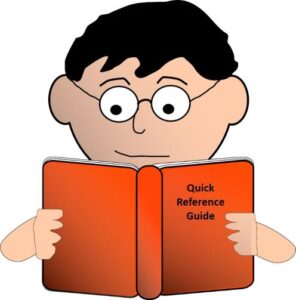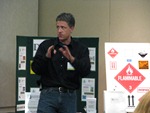Federal regulations of the U.S. Environmental Protection Agency (USEPA) at 40 CFR 262.17(a)(6) require a large quantity generator of hazardous waste (LQG) to comply with the preparedness, prevention, and emergency procedure standards of 40 CFR 262, subpart M. This article is the tenth in a series that looks closely at each of the sections in subpart M to clearly describe the responsibilities of a LQG.
The purpose of this article is to address the requirements of 40 CFR 262.262 Copies of contingency plan.
Before we begin…
These regulations were revised by the Generator Improvements Rule. If your state has not yet adopted the new rule you must continue to comply with the earlier version until it does. You may read an article explaining the earlier version of the regulations (prior to implementation of the Generator Improvements Rule) here.
Not sure of your hazardous waste generator status? |
Scope and Applicability:
These regulations are applicable to a LQG. A small quantity generator of hazardous waste (SQG) is subject to entirely different requirements for emergency response. If you are a SQG please refer to this article for your version of these regulations: Preparedness, Prevention, and Emergency Procedures for Small Quantity Generator of Hazardous Waste.
As made clear by §262.250 (revised by the Generator Improvements Rule), the preparedness, prevention, and emergency procedures of Subpart M are applicable to those areas of a LQG where hazardous waste is generated or accumulated. This includes:
- Central Accumulation Area (CAA)
- Satellite Accumulation Area (SAA)
Read: Applicability of Preparedness, Prevention, and Emergency Procedures for LQG
40 CFR 262.262 reads:
A copy of the contingency plan and all revisions to the plan must be maintained at the large quantity generator and—
(a) The large quantity generator must submit a copy of the contingency plan and all revisions to all local emergency responders (i.e., police departments, fire departments, hospitals and State and local emergency response teams that may be called upon to provide emergency services). This document may also be submitted to the Local Emergency Planning Committee, as appropriate.
(b) A large quantity generator that first becomes subject to these provisions after May 30, 2017 or a large quantity generator that is otherwise amending its contingency plan must at that time submit a quick reference guide of the contingency plan to the local emergency responders identified at paragraph (a) of this section or, as appropriate, the Local Emergency Planning Committee. The quick reference guide must include the following elements:
(1) The types/names of hazardous wastes in layman’s terms and the associated hazard associated with each hazardous waste present at any one time (e.g., toxic paint wastes, spent ignitable solvent, corrosive acid);
(2) The estimated maximum amount of each hazardous waste that may be present at any one time;
(3) The identification of any hazardous wastes where exposure would require unique or special treatment by medical or hospital staff;
(4) A map of the facility showing where hazardous wastes are generated, accumulated and treated and routes for accessing these wastes;
(5) A street map of the facility in relation to surrounding businesses, schools and residential areas to understand how best to get to the facility and also evacuate citizens and workers;
(6) The locations of water supply (e.g., fire hydrant and its flow rate);
(7) The identification of on-site notification systems (e.g., a fire alarm that rings off site, smoke alarms); and
(8) The name of the emergency coordinator(s) and 7/24-hour emergency telephone number(s) or, in the case of a facility where an emergency coordinator is continuously on duty, the emergency telephone number for the emergency coordinator.
(c) Generators must update, if necessary, their quick reference guides, whenever the contingency plan is amended and submit these documents to the local emergency responders identified at paragraph (a) of this section or, as appropriate, the Local Emergency Planning Committee.
Daniels Training Services, Inc. 815.821.1550 |
Why the change?
A minor change in text but significant in effect is found throughout Subpart M. It is the change of text from “owner or operator” or “facility” to “generator” or “large quantity generator”. This reinforces the applicability of the revised regulations to solely a large quantity generator of hazardous waste.
The big change to this section of the preparedness, prevention, and emergency response procedures is the requirement for the LQG to submit a quick reference guide of the contingency plan. More on that below.
Didja’ know? In its original proposal of these regulations USEPA referred to this document as an “executive summary”. It was changed to “quick reference guide” to better convey the fact that it should be prepared in a format enabling first responders to quickly access key information in the event of an emergency.
Up to Date and On-Site:
The LQG must maintain an up to date copy of its contingency plan including all revisions made to it while in effect. In short, USEPA is not interested in past emergency procedures at a LQG, only those in use in the most recent revision. Unlike other recordkeeping requirements for a LQG, those for the contingency plan do not require the maintenance of past copies (usually for at least three years) as a record of past compliance.
§262.263 does not mandate a frequency for review or amendment of the contingency plan. As the generator it is your responsibility to ensure the contingency plan reflects the current operations and hazardous waste management at your facility. Think of the contingency plan as the ‘Who? What? Where? When? Why? How?’ right now at your facility. The USEPA has no interest in what your contingency plan looked like last year.
Also different from other LQG recordkeeping requirements is the explicit responsibility to maintain the contingency plan and all revisions at the LQG. This means the contingency plan must be readily available at the physical location of the LQG not at a central location, headquarters, office or off-site contractor or consultant, even if those locations are more convenient for retrieval. Whatever is identified as the geographic location of the LQG is where an up to date copy of its contingency plan must be maintained.
Read: The Recordkeeping Requirements for Contingency Plans
Submit Copies to all Local Emergency Responders (but not ALL of them):
In addition to maintaining an up to date copy – and all revisions – at the site of its hazardous waste generation and management, the LQG must submit copies to the following local emergency responders:
- Police departments
- Fire departments
- Hospitals
- State and local emergency response teams that may be called upon to provide emergency services.
- It may also be submitted to the Local Emergency Planning Committee (LEPC), as appropriate. It is up to the LQG to determine if there is an LEPC in its area and, if so, if it is active and interested in receiving a copy of the contingency plan.
Noticeably absent from this list of local emergency responders but included in the requirements to attempt to make arrangements with local authorities (§262.256) and to document arrangements agreed to with those local emergency responders (§262.261) are the following:
- Emergency response contractors
- Equipment suppliers
So, while an LQG is required to attempt to make arrangements and reach agreement with both emergency response contractors and equipment suppliers – if you may call upon their services in an emergency – an LQG is not required to provide them with a copy of the contingency plan, though you may choose to do so.
That it?
No. Subject to new regulations under the Generator Improvements Rule, the LQG must now submit a quick reference guide of the contingency plan to the local emergency responders identified above.
 More on the quick reference guide:
More on the quick reference guide:
- An existing LQG is not required to submit the quick reference guide (though it may do so). Submittal of the quick reference guide to local emergency responders is required only of the following:
- A person that becomes a LQG after the effective date of the Generator Improvements Rule (05.30.17) and submits its first contingency plan.
- A LQG that amends its contingency plan after 05.30.17 and submits an amended contingency plan.
- The quick reference guide is not part of the contingency plan. It is a separate “stand alone” document.
- The LQG is not required to maintain a copy of the quick reference guide at its location as it is for the contingency plan.
- The quick reference guide is meant to provide readily available information describing what emergency responders will immediately confront upon arrival at the LQG.
- The LQG must update, if necessary, the quick reference guide whenever the contingency plan is updated and submit both to the local emergency responders identified above.
What’s in the Quick Reference Guide?
Contact me the next time hazardous waste generator USEPA training is due to expire. |
The quick reference guide must include the following elements:
- The types/names of hazardous wastes in layman’s terms and the associated hazard associated with each hazardous waste present at any one time (e.g., toxic paint wastes, spent ignitable solvent, corrosive acid).
- The estimated maximum amount of each hazardous waste that may be present at any one time.
- The identification of any hazardous wastes where exposure would require unique or special treatment by medical or hospital staff.
- A map of the facility showing where hazardous wastes are generated, accumulated and treated and routes for accessing these wastes.
- A street map of the facility in relation to surrounding businesses, schools and residential areas to understand how best to get to the facility and also evacuate citizens and workers.
- The locations of water supply (e.g., fire hydrant and its flow rate).
- The identification of on-site notification systems (e.g., a fire alarm that rings off site, smoke alarms).
- The name of the emergency coordinator(s) and 7/24-hour emergency telephone number(s) or, in the case of a facility where an emergency coordinator is continuously on duty, the emergency telephone number for the emergency coordinator.
The last bullet point is to account for situations where an emergency coordinator is continuously on duty. It is consistent with the regulations of §262.261(d).
Is that it?
No. First of all, as a LQG you must still comply with the remaining requirements of §262, subpart M which have been moved from their former location at §265, subpart D and were revised by the Generator Improvements Rule.
And then, what about training? At §262.17(b)(7) – directly following the referral to emergency procedures – are the training requirements for a LQG. §262.17(b)(7)(i)(C) reads in part:
At a minimum, the training program must be designed to ensure that facility personnel are able to respond effectively to emergencies…
So clearly, Hazardous Waste Personnel Training at a LQG is important.


